Volkswagen Caddy Life 2.0 TDI DSG
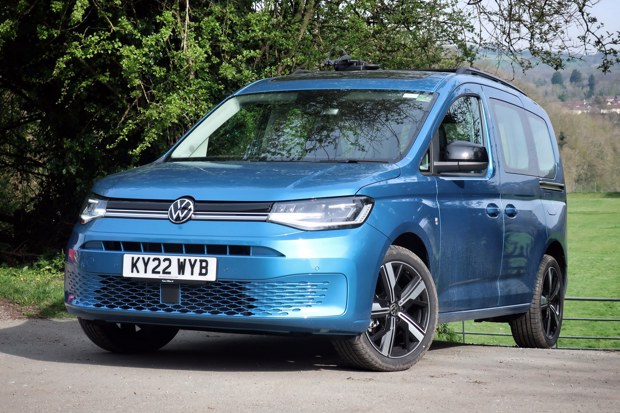
Specifications: Volkswagen Caddy Life SWB 2.0 TDI DSG
- Run by: Andy Brady since April 2022
- Price when new: £32,859 (£41,793 including options)
- Engine: 2.0-litre diesel
- Power: 122PS
- Torque: 320Nm
- Claimed economy: 54.7mpg
- CO2 emissions: 136g/km
- Insurance group: 12E
- Report 1: We're living the Caddy Life with our latest test car
- Report 2: How to spec a Volkswagen Caddy
- Report 3: Using the Volkswagen Caddy to carry bikes and kayaks
- Report 4: Should I buy a Volkswagen Caddy California?
- Report 5: How practical is the Volkswagen Caddy?
- Report 6: Is the Mercedes T-Class better than a Volkswagen Caddy?
- Report 7: Disaster... bike strike in the Volkswagen Caddy
- Report 8: What would an electric Volkswagen Caddy be like?
- Report 9: How reliable is a Volkswagen Caddy?
- Report 10: Goodbye to the Volkswagen Caddy
Report 1: We're living the Caddy Life with our latest test car
We've added a Volkswagen Caddy to the HonestJohn.co.uk long-term test fleet.

Date: 16 May 2022 | Current mileage: 150 | Claimed economy: 54.7mpg | Actual economy: 47.2mpg
I've been waiting for this car for a very long time. I initially ordered 'my' Volkswagen Caddy back in summer 2021. The estimated delivery date I was given was November. And then it was February. And then it finally arrived in April 2022.
The ongoing microchip shortage means new car buyers are facing massive delays in delivery times. And, believe it or not, Volkswagen is reluctant to bump a press vehicle up the waiting list at the expense of a customer's car. Quite rightly, too.
Besides, I didn't really want the Volkswagen Caddy over winter. It's a summer car. Not in a Mazda MX-5 kinda way, but in a lifestyle-enabling "let's go camping at the weekend" kinda way. So its arrival a few days ahead of the recent bank holiday weekend could not have been better timed.
I'll do a full run down of the optional extras fitted to my Caddy in a future update (spoiler: those listed in the graphic above aren't all of them). But VW's also chucked on some dealer-fit roof bars and a bike rack so I can go full lifestyle (I once tried to achieve a similar effect with a Peugeot Rifter but it still looked like a van with windows).
My first trip in the Caddy was into North Wales, mountain bike and all. I stopped at a services somewhere near the border and a man dressed head-to-toe in North Face clothing told me the Caddy looked cool. Winner.
Anyway, it'll be interesting to see what life with this van-based people carrier is like. Not that the Volkswagen Caddy is a van-based people carrier. The latest model has been shifted onto the MQB platform – that's the same as you'll find underpinning everything from the Audi TT to the Skoda Karoq. So, while the old model was a van-based people carrier, this is actually a car-based people carrier that also happens to look a bit like a van.
You'd expect it to be more car-like and less utilitarian to drive, then. You might well be right – again, we'll answer that at a later date (I can't give away my best material week one of our six-month test).
In the meantime, if you have any specific questions about the Volkswagen Caddy (or perhaps you own one and want to tell me your thoughts), do drop us a note via Ask HJ.
Report 2: How to spec a Volkswagen Caddy
Wrangling with the online configurator? These are the must-have options on a Volkswagen Caddy Life.
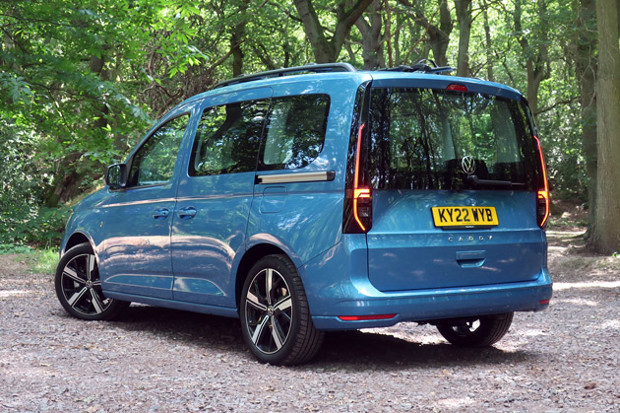
Date: 30 May 2022 | Current mileage: 789 | Claimed economy: 54.7mpg | Actual economy: 45.3mpg
It's probably an exaggeration to say that no two Volkswagen Caddys are ever the same, but it's certainly a vehicle that's offered in a wide range of colour, trim and engine combinations – you can even get it in different lengths and body styles. I spent an unhealthy amount of time on Volkswagen's configurator coming up with the ideal spec for our Caddy – so I thought it'd be useful to run through which option boxes I ticked (spoiler: most of them) and, perhaps more crucially, which I didn't.
I started with a Volkswagen Caddy Life, which is the plushest Caddy passenger car you can get – adding things like an 8.25-inch infotainment system (with Apple CarPlay and Android Auto), front/rear parking sensors, black roof rails and LED rear lights to the standard model.
In terms of wheelbase, I opted for the standard SWB model. That's because I figured I didn't need the extra length (or the extra seats) of the long-wheelbase Caddy Maxi, while the extra dexterity of the short-wheelbase appealed. We'll come onto whether that was the right decision in a future update.
Diesel power might be well out of fashion in 2022, but I decided the 2.0-litre TDI engine would be better suited to the Caddy than the 1.5 petrol. While the turbocharged petrol unit is great in a smaller car, the Caddy's not a light vehicle, so the extra torque provided by the diesel engine will come in handy. I'll mainly be using it for long motorway journeys, too, so it's not like I'm going to be adding to air pollution in built-up areas. I also went for the DSG automatic gearbox because I've got no desire to start changing gears myself in a people carrier like the Caddy.
I wanted a bold paint colour (and the Caddy's available in some brilliant hues) – so it came down to Golden Green Metallic or Costa Azul Metallic. I chose the latter and I'm very glad it did – it's one of the best new car colours available, in my opinion. Not everyone agrees but it'd be a boring world if we all drove silver cars, wouldn't it?
Ordinarily we'd recommend choosing small alloy wheels (and bump-absorbing high-profile tyres) but I'm a sucker for aesthetics, so opted for the biggest wheels you can get on a Caddy – the optional 'Monterosso' alloys, at a cost of £1188. Only time will tell whether I regret that decision, but I do think they look much better than the smaller wheels.
Further optional extras included the upgraded 10-inch navigation system (£2022), the Digital Cockpit (£486), rear-view camera (£282), adaptive cruise control (£696) and panoramic glass roof (£972). I also opted for the £528 Winter pack with its heated seats, heated door mirrors and heated front washer jets, all desirable features for a British summer.
So, there we are. The total price for our Volkswagen Caddy, including options, is nudging £42,000 – quite a bit more than the most affordable passenger-carrying model (which starts from less than £26,000). Keep an eye on our updates to see which ones are worth splashing the cash on, and which you can probably avoid if you're speccing a Caddy yourself.
Report 3: Using the Volkswagen Caddy to carry bikes and kayaks
We put our Volkswagen Caddy to the test as a triathlon support vehicle.

Date: 13 June 2022 | Current mileage: 1487 | Claimed economy: 54.7mpg | Actual economy: 44.8mpg
When I ordered our Volkswagen Caddy, I told everyone who'd listen it was going to be a 'lifestyle enabler'. I'd fallen for the marketing hype and had grand ideas of chucking a mountain bike in the back, fixing a canoe to the roof and hitting the road for weekends of outdoor pursuits.
And, actually, I have been using it that way. During the week the Caddy spends most of its time on the M40 heading back and forth between home and Heathrow Airport or various UK car launches, but at the weekend it really comes into its own.
I recently took part in the Montgomery Canal Triathlon in the Welsh borders. Unlike a traditional triathlon, the usual swimming element is replaced by kayaking (the brown murky water of the part-restored Montgomery Canal doesn't lend itself to swimming).
It's the second time I've entered the event and, as I found out last time, the challenging part isn't the triathlon itself – it's the logistics of getting there and making sure you, your kayak and your bike are in the right place at the right time. And the Caddy proved itself as a very capable triathlon support vehicle.
Loading the kayak onto the roof is much easier than it used to be than on my old Land Rover Freelander 2 – presumably it's slightly lower; I can certainly do it myself with little hassle. Having nearly lost the kayak in the past, I strapped it down very tight. Too tight, in fact, which meant the straps vibrated and made a bit of a din above 50mph. Loosening them off ever-so-slightly and adding a few twists soon fixed that.
Although I do have a bike carrier on the roof of the Caddy, I usually find it easier just to drop the seats and chuck my mountain bike in the back. That's especially true when you're also carrying a kayak – the straps for this get in the way of any bike on the roof. You can probably get a kayak holder attachment that'd enable you to carry both a bike and kayak at the same time, but I've never really felt the need.
The night before the event, I loaded the various locations as favourites into Google Maps, which meant I could easily navigate between them using Android Auto on the Caddy's display. I'd been smart enough to include a nearby McDonald's as a waypoint for breakfast, too.
I'm pleased to say the Caddy took any stress out of the day, and I was very glad to jump into it for the home journey three and half(ish) hours later. It was a hot day, so the optional winter pack wasn't as necessary as I thought it might have been for such a situation, but the hassle-free DSG automatic gearbox and super-cool climate control were very welcome.
Report 4: Should I buy a Volkswagen Caddy California?
We spend a weekend with the Volkswagen Caddy California camper van to see how it compares to our Caddy Life.

Date: 27 June 2022 | Current mileage: 2101 | Claimed economy: 54.7mpg | Actual economy: 49.6mpg
The Volkswagen brand is synonymous with camper vans, with the manufacturer struggling to meet demand for its California and Grand California models. Rumour has it, VW campers account for roughly one in three vehicles in Devon over the summer months (note: this figure hasn't been substantiated).
Micro campers – that is small campers based on vans like the Volkswagen Caddy and Citroen Berlingo – are very much in-vogue in 2022, with buyers particularly keen on low-cost getaways. The appeal is obvious, buy a miniature camper van and you can drive it to the office every day with little hassle, and then hit the road for weekend camping trims whenever the fancy takes you.
While the relatively compact Caddy hasn't been available as an official conversion in the past, it's becoming increasingly popular with aftermarket conversion specialists. And that's why Volkswagen's decided now is the right time to launch a Volkswagen Caddy California.
We've recently had one in on test and, while you can read our full review here, I figured it might be interesting to make some notes about how it compares to our Caddy Life.
For a start, our Caddy California test car was based on the long-wheelbase Caddy Maxi. That means you get some welcome extra interior space, but it still isn't exactly bulky for negotiating tight lanes or crowded campsites. Indeed, our week with the Caddy California coincided with a trip to the Calder Valley, an area that isn't exactly known for its main roads and wide open spaces.
My first impression of the Volkswagen Caddy California was a little along the lines of 'is that it?'. It really does look just like a regular Caddy, albeit one with a fold-out bed, some flimsy window covers and a pull-out single-burner hob. But it's meant to be back-to-basics and, with a list price from around £30,000, it's considerably more affordable than fancier camper vans and motorhomes.
It's easy to turn the Caddy into a home, though, with the pull-out bed proving surprisingly comfortable (almost spacious, even...) for a two-night weekend getaway. The extra warmth provided by the Caddy's cabin, along with electricity for charging gadgets, proved to be very welcome – although I'd probably be inclined to spec the optional tent awning for some extra weather protection when cooking.
Any cynicism over the Volkswagen Caddy California was banished after a weekend away. My only complaints were that our test vehicle wasn't as well-equipped as our Volkswagen Caddy test car – but that's nothing a raid of the options list can't fix. Features like Apple CarPlay/Android Auto and a reversing camera are hard to live without once you're used to them.
Report 5: How practical is the Volkswagen Caddy?
We put the Volkswagen Caddy to test with a four-piece set of Mrs Hinch garden furniture.

Date: 11 July 2022 | Current mileage: 2972 | Claimed economy: 54.7mpg | Actual economy: 48.3mpg
If you're looking to buy a Volkswagen Caddy, chances are it's because you value things like boot space and general versatility more than stylish looks or a go-kart-like driving experience. And, despite the popularity of family SUVs like the Nissan Qashqai, you still can't beat a traditional people carrier for outright practicality.
The passenger-carrying Volkswagen Caddy is available in two lengths: the regular Caddy and the long-wheelbase Caddy Maxi. Our Caddy is the shorter version, which means it measures 4500mm in length, 2100mm in width (including door mirrors) and 1832mm in height (including the standard-fit roof rails, but not the bike carrier fitted to our Caddy).
The Volkswagen Caddy has a wheelbase (that's the space between the front and rear wheels) of 2970mm. This increases by 215mm in the Caddy Maxi, while the overall length of the Caddy Maxi is 353mm longer than the standard car. This obviously translates into more interior space for passengers as well as a bigger boot.
Ah, boot space. Our Volkswagen Caddy has a huge 1213-litre boot behind the second row of seats – that's more than twice as much space as you'd get in a Qashqai. Go for the optional seven-seater package and space in the boot drops to a tiny 191 litres of space (less than you get in the new Toyota Aygo X city car).
If you're looking to travel seven-up (that's seven passengers, not the fizzy drink), you'd be better forking out the cash for the long-wheelbase Volkswagen Caddy Maxi. This has a more useable 446-litre of boot space behind the third row of seats, increasing to a huge 1720 litres of space with them removed.
What does all this mean in the real world? Well, we've covered how useful the Volkswagen Caddy is for carrying bikes and kayaks, but our Caddy was recently pressed into action when a neighbour wanted help transporting a four-piece Mrs Hinch outdoor dining set. It all came packaged in a box that, in theory, would fit in the Caddy's boot (which Volkswagen says is 1913mm long and 1185mm wide behind the front seats).
The rear seats split 60:40 and can be dropped easily, while they also have the ability to flip forward (providing a flat floor but intruding into the overall length of the boot space). I often find it's easiest just to drop them and lift whatever I'm transporting up onto the backs of the seats, providing some crucial extra length (every millimetre counts, it turns out).
So that's what we did. Between myself, Andy (my neighbour) and a friendly Tesco security guard, we loaded the large box into the back of the Caddy without too much effort. The low boot lip helped massively here, as did the huge opening tailgate. Would an SUV have made such light work of transporting a bulky item? Not a chance.
Report 6: Is the Mercedes T-Class better than a Volkswagen Caddy?
We head to Frankfurt to find out how the new Mercedes T-Class compares to our Volkswagen Caddy.
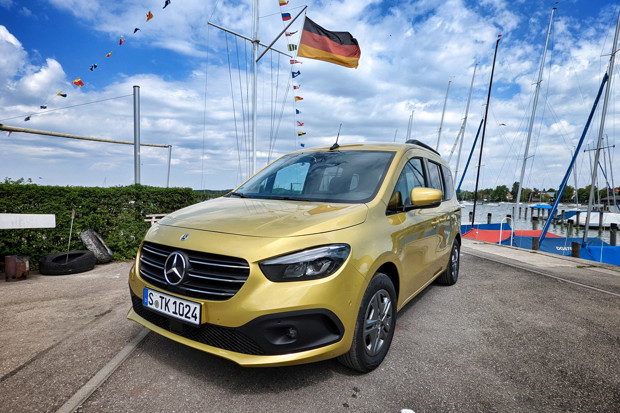
Date: 22 July 2022 | Current mileage: 3776 | Claimed economy: 54.7mpg | Actual economy: 45.6mpg
I think it's fair to say that the majority of van-based people carrier buyers care more about versatility than image. No one buys a Citroen Berlingo because they want to look cool. If you're the trendy type, you'd have a Kia Sportage on your driveway like everyone else.
I'd argue that people carriers can be cooler than SUVs, though. My Volkswagen Caddy looks the business when it's loaded up with kayaks and bikes, while its optional 18-inch alloy wheels and Costa Azul metallic paint has already attracted praise from strangers in car parks. Volkswagen has some heritage in making desirable commercial vehicles, too – you only need to look at prices of secondhand Volkswagen California campervans to see how on-trend they can be.
So what else can you buy if you want a van-based people carrier that doesn't look a bit fuddy-duddy? Well, there's a new Mercedes T-Class on its way. Set to go on sale later in the year with prices expected to start from around £30,000, the new T-Class will sit as a direct rival to the Caddy – combining the snob-appeal of the Mercedes-Benz badge with van-like versatility.
One of my many recent schleps down the M40 to Heathrow was for the European launch of the Mercedes T-Class out in Frankfurt. You can read my detailed thoughts on the new Mercedes T-Class here, but I thought it might be interesting to make a few brief comparisons between the T-Class and a car I'm becoming very fond off, the Volkswagen Caddy.
Just like the Caddy, the Mercedes T-Class shares parts with other models. It's based on the Mercedes Citan van, which itself is based on the Renault Kangoo. While it's obviously not in the same league inside as a Mercedes S-Class, the T-Class has clearly been 'poshed up' to make it worthy of the Mercedes badge. You get soft-touch materials aplenty as well as a slick (but small) MBUX infotainment system. It probably has the edge over the Caddy in terms of car-like useability.
But how does it stack up on all-important versatility? Well, in the first instance the T-Class will only be available as a short-wheelbase five-seater, much the same as my Caddy. And it scores pretty well for practicality, although its van-like 2127-litre maximum luggage capacity (with the rear seats dropped) isn't quite as capacious as the Caddy's huge 2556 litres.
And what about engines? Just like the Caddy it snubs hybrid and electric power in favour of an old-fashioned diesel engine. We're unlikely to get a petrol T-Class in the UK; instead, the sole offering is expected to be the 1.5-litre T180d. It's a smaller capacity unit than my Caddy and the figures reflect this – power is down to 116PS compared to the Caddy's 122PS, while it'll reach 62mph in a leisurely 13.6 seconds (compared to 11.4 seconds in the Caddy). While we reckon you'd notice the extra punchiness of the Caddy if driven back-to-back with the T-Class, we don't think the Mercedes feels quite as lethargic as the figures suggest.
Ultimately, we'll have to wait until the new Mercedes T-Class arrives in the UK for the final verdict on how it compares with the Caddy. UK pricing – which has yet to be announced – will play a big part in its fate, too. But if you are in the market for an upmarket van-based people carrier, it might be worth waiting for the T-Class before you slap a deposit down on the Volkswagen Caddy...
Report 7: Disaster... bike strike in the Volkswagen Caddy
We pick a battle with a tree and the tree wins.
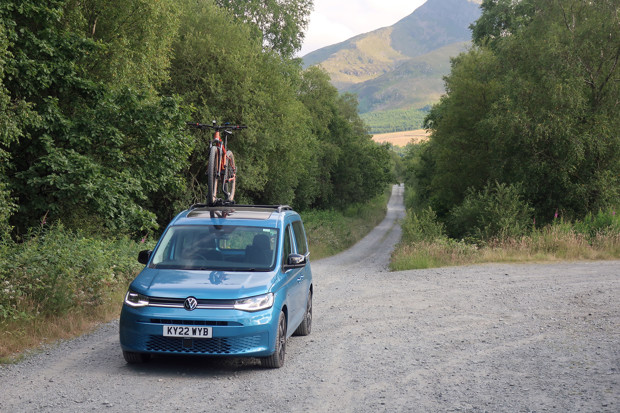
Date: 5 August 2022 | Current mileage: 4328 | Claimed economy: 54.7mpg | Actual economy: 47.8mpg
Sooner or later, it was going to happen. The Volkswagen Caddy makes such little fuss out of transporting my mountain bike that it was only a matter of time before I'd forget it was on the roof.
Fortunately, it wasn't a car park height barrier I struck or even a particularly low tree. It was quite a high tree, with branches hanging over the bumpy access road to a bike park in North Wales. There was the awful noise of snapping branches and I looked up through the Caddy's panoramic sunroof to see my bike in the foliage (not for the first time that day, as it happened).
Fortunately, again, the damage was minimal. My bell was smashed to pieces but the rest of the bike was quite alright. Lesson learnt, I'll be a bit more careful in the future.
After posting the above picture on Twitter, someone asked how easy it is to lift the bike onto the Caddy's roof. And, actually, it's not too bad. I'm a bit of a weakling and my hardtail is on the weightier end of the scale, but I still find it a lot easier to secure than on our old Peugeot Rifter test car. It's just about doable with one person and I'm yet to drop the bike through the glass roof.
That said, I still find it easier to chuck the bike into the back of the Caddy 90 per cent of the time. Sure, I'd probably be less keen after grinding through thick winter mud, but for now I'm happy to drop the back seats and carry the bike in the back, safe in the knowledge it's not going to come to any harm for overhanging trees.
Bike carrying shenanigans aside, life with the Volkswagen Caddy is proving reassuringly easy. A recent trip to transport a garden furniture set for a neighbour gave me the confidence to collect an oak bookcase when the delivery van broke down. It only just fit (a long-wheelbase Caddy Maxi would have made lighter work of it...) but we got it in.
Indeed, the Volkswagen Caddy's usefulness means colleagues are now eyeing it up for family holidays, house moves and Ikea trips, so I suspect my time as its custodian may soon be coming to an end.
That's a shame as, during the last four months or so, it's convinced me that it's one of the best all-rounders you can buy. And I think it's cooler than an SUV.
Report 8: What would an electric Volkswagen Caddy be like?
With the world moving towards electric power, we wonder whether an electric Volkswagen Caddy would be the ultimate all-rounder...
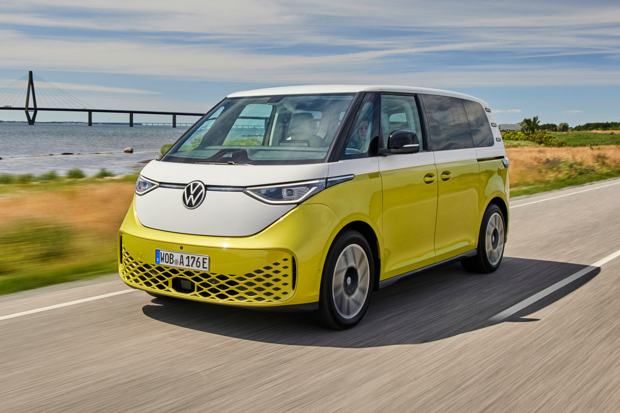
Date: 19 August 2022 | Current mileage: 4558 | Claimed economy: 54.7mpg | Actual economy: 47.3mpg
As one of HonestJohn.co.uk's team of reviewers, you probably won't be surprised to hear that I'm currently spending a considerable chunk of my time driving the latest electric cars. And, generally, I'm quite happy with that - I love how electric cars drive, with their instant acceleration, impressive refinement and, of course, no need to visit a petrol station.
As much as I like my Volkswagen Caddy, starting up its grumbly diesel engine does feel a bit like a step back in time after a week with a new electric vehicle. The Caddy's engine line-up is pretty limited, though - you can choose from the 2.0 TDI diesel (like mine) with a six-speed manual or seven-speed DSG automatic gearbox; or a 1.5-litre petrol engine like you'd get in a Golf. I haven't tried a petrol Caddy but, with just 114PS, I expect it might feel a bit underwhelming, especially when fully loaded.
You can't get the Caddy with the merest hint of electrification - not even mild-hybrid assistance, although a plug-in hybrid test mule has been spied. That could be the ideal compromise for a lot of people - do the school run in a silent zero-emission bubble of smugness, keeping a petrol engine on hand for weekend adventures.
But what I'd really like is a pure-electric Volkswagen Caddy. An all-electric version of the old Caddy was briefly offered in Europe but that idea was shelved for the latest model - mainly because it's based on the MQB platform, while Volkswagen's electric vehicles (including the new ID.Buzz, pictured above) sit on the brand's MEB electric car architecture.
Will we see an electric version of the Caddy in the future? It's likely to be a long way off but, if the Caddy is to survive, then it's only a matter of time. Volkswagen is working with Ford in a number of areas including commercial vehicles and electric car expertise, so the brands could well collaborate to produce a next-generation electric Caddy-slash-Tourneo Connect.
Talking of which, have you seen the current Ford Tourneo Connect? It's based on the Caddy and looks a lot like its German relation. There's a rumour that we'll see a plug-in hybrid Tourneo Connect, too.
Report 9: How reliable is a Volkswagen Caddy?
We reveal any common faults with the Volkswagen Caddy.
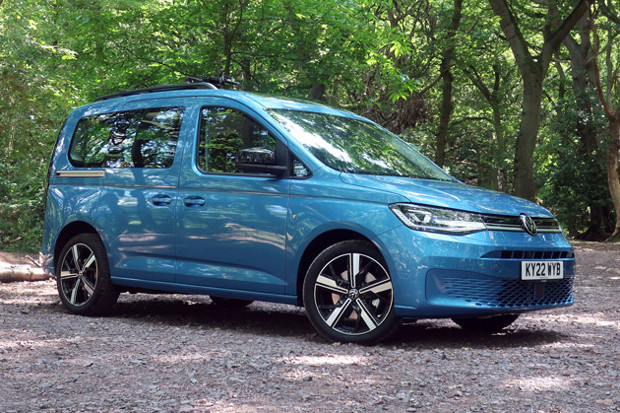
Date: 2 September 2022 | Current mileage: 4783 | Claimed economy: 54.7mpg | Actual economy: 48.1mpg
We like to run cars for an extended period as it gives us an idea of how reliable they are in the long-term. No, you wouldn't necessarily expect any major issues from a six-month-old car, but you'd be surprised how often modern cars can go wrong.
So, if you're wondering how reliable a Volkswagen Caddy is, this update's for you. And it's going to be a short one because, frankly, nothing's really gone wrong [Edit: something has gone wrong since this was written, details below].
The only thing close to an incident I've had with the Volkswagen Caddy was a slight grumble from the power steering. It was a really hot day and I'd been working the Caddy hard on mountainous Welsh roads, so I put it down to something overheating and stopped at McDonald's for a McFlurry. The noise went away and hasn't returned.
Owners seem to be similarly happy with their Caddy, too. We haven't had any issues reported with the Caddy - if you'd like to do so, please do contact us via the Ask HJ feature and we'll add your report to the good/bad section of our review.
26th Nov: UPDATE
It's the age-old "don't say it too soon" problem. A couple of months after we posted this relatively problem-free report the Volkswagen Caddy has flashed up the airbag warning light and "Error: airbag" on the digital dials. Needless to say it isn't the most comforting warning message to see, but we're hoping it's an iffy sensor or something as nothing else seems to be awry.
Well, actually, we have been getting the odd message about the car's 'Front Assist' collision warning popping up on the dash, too. Normally that would indicate poor weather or a dirty front-end covering the radar or camera system, but the car is clean and it happens in the dry. It's a slightly disappointing end to our time with the car just before it goes back - although we'd no doubt both would be dealt with easily in a visit to a dealer.
Report 10: Goodbye to the Volkswagen Caddy
After six months, it's time to say goodbye to our Volkswagen Caddy Life.

Date: 16 September 2022 | Current mileage: 5012 | Claimed economy: 54.7mpg | Actual economy: 46.7mpg
And there we are. Six months of living the Caddy Life has come to an end.
It's been a busy summer - lots of cycling, shuffling passengers around and pounding the M40 between home in Shropshire and our London office. The Caddy has taken it all in its stride.
I joked when it arrived that the Caddy was a 'lifestyle enabler'. And it is. Its astounding versatility, frugal running costs and long-distance comfort means there are very few cars I'd rather have spent the last six months with.
What would I have changed if I was going back to the start and speccing the Caddy again? Not a lot. I love the colour, I love the specification, I love the many option boxes I ticked. The punchy diesel engine suits the Caddy well (even if I would prefer a plug-in hybrid or even electric power...), while the DSG gearbox has generally been excellent.
There have been a few occasions when the longer-wheelbase model would have come in handy, as would an extra pair of seats. I was worried about running something so big as a daily driver when it first arrived, but I soon got used to the Caddy's dimensions.
And the ultimate question is, would I buy a Caddy over an SUV? I think I would. I actually quite like an SUV and totally understand their boom in popularity. But I think the Caddy looks pretty cool (particularly for a van) and has the kudos of the VW badge, while it's proved itself to be a brilliant load-lugger.
So that's that, the Caddy's off to its next owner and there's a car-based-van-shaped gap in my life...
